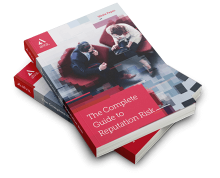Reputation: the social contract barometer
A positive reputation strengthens market position, reduces the price of capital and increases shareholder value. It can also insulate the brand, allow for higher prices and help to attract the best people. In times when trust is under scrutiny, a positive reputation is well worth having, but it cannot result from manipulation. It must come from the authentic identity of the company.
Countless academic studies and papers have tried to explain reputation and why it matters. The best definition is the simplest: reputation is what others think of you. It manifests based on what you do, what you say, and what you achieve.
In the business context, reputation is based on the company’s behaviour, communications and performance in all areas of the business. Many businesses still believe that reputation is something that can be “managed” separately from the fundamental business, but reputation is not a construct; reputation is an outcome. An authentic reputation evolves from being consistent in word and deed over time. A more helpful way to understand a company’s reputation might be to consider it as a feedback mechanism of the company’s viability and overall performance.
Reputation is itself an outcome, but it needn’t be a single outcome; companies have, in fact, multiple reputations. For instance, let’s look at the reputation of an oil and gas company through three different stakeholder lenses. The company might have a generally poor reputation for social responsibility in the communities where it operates, it might have a good reputation among shareholders for delivering healthy returns, and employees might feel equally positive about the company for providing a good employee experience. Each of the three stakeholder groups will assess the health of the relationship with the oil company based on a different set of personal expectations, which will result in different reputations. Reputation is in the eye of the stakeholder, and all companies have multiple stakeholders.
How authentic reputations are formed
Authentic connection with stakeholders can only happen when the engagement is based on the company’s true identity, which, as Professor Grahame R Dowling puts it in his book Winning the Reputation Game, manifests in the company’s objectives, character and competence. These three components are in turn manifested in the company’s communication, behaviour and performance, thus forming the multiple reputations of the company. Authentic reputations need to emerge naturally from the company’s identity before other tactics will work. Companies that are more “connected” and embed reputation in their identity are likely to acquire a stronger reputation, and the goodwill of those relationships can help to provide a support base in difficult times.
According to Richard Woods, formerly of Capital One, strong reputations are supported by two pillars: “Pillar number one is becoming famous for something compelling. Pillar number two is managing risk to the company’s reputation. Companies need strategies to ensure that they become well-known for the great things they’re doing but don’t become infamous for the other choices they make along the way.”
Authenticity comes from your identity
Understanding the company’s identity will help the company understand what it can and can’t do and how to achieve agility and authenticity in a changing world. Identity is not to be confused with the DNA, although at times, it’s used to imply the same concept. We know from biology that DNA contains the instructions an organism needs to develop, function and reproduce. It is formed at conception and does not change. However, the same DNA can express itself in different ways based on one’s environment.
Let’s take a look at the three components that define the company’s identity: Objectives, Character and Competence.
Objectives
In today’s business sector, we frequently find companies deploying resources on a large scale without any clear notion of what their purpose is. The objectives and strategy have no connection with any other purpose beyond creating economic value. Robin Nuttall, a partner at McKinsey and co-author of the book Connect, has highlighted that “the first objective is [to] define a purpose which is clear but also which is bold; [purpose] is the most important driver of performance rather than a feel-good factor where no one is really sure what they’re doing.”
Companies must be clear about the role of the business in society and align objectives and strategy with the pursuit of the authentic purpose, thus becoming better connected.
Character
Character is the second component of the company’s identity, which can be found in its vision, mission, ethics, credo and values. These are the behavioural norms of the company, or “the way things are done here”.
According to Ron Carucci, co-founder and managing partner at Navalent, employees want their company’s values to be sacrosanct. When they aren’t, the logical conclusion workers draw is that the organisation doesn’t mean what it says – and that it’s perfectly acceptable to behave in ways that contradict the stated values.
Another comprehensive study based on more than 1,000 firms on the Great Place to Work list reveals a strong correlation between a company’s financial performance and the extent to which employees believe their company’s espoused values are practised. Values hold the power to drive meaningful differences in performance by shaping a culture, and when misused, can undermine its performance with toxic force.
True cultural norms drive results and engender strong communal pride. Culture in such companies becomes a competitive advantage that attracts top talent and must reflect what makes it uniquely successful, conveying to employees, “This is what it takes to succeed here.” Processes like strategy, selection, rewards, performance management and resource allocation must have values woven deeply into them with undeniable consistency between actions and words.
While mission statements are widely misused in businesses today, we can find a handful of companies that have used them successfully by embedding the strong values that have guided their decision-making, and helped them flourish over more than a century.
Competence
Competence is the final component of the company’s identity, which is made up of a cluster of related abilities, commitments, knowledge and skills that enable an organisation to act effectively in a job or situation. Competence indicates sufficiency of knowledge and skills that enable the business to deliver in line with stakeholders’ expectations, and will vary from company to company.
In order to build the identity that will lead to an authentic reputation, each of these elements needs the same attention. A company will appear untrustworthy in the long run if it is not behaving in line with social norms, even if it’s being very competent and achieving significant profits.
This piece was developed from The Connecting Leader: In the Age of Hyper-Transparency, Interconnectivity and Media Anarchy, How Corporate Leaders Connect Business with Society, by Alberto Lopez Valenzuela. A link to the book can be found here.
alva’s Reputation Intelligence holds a mirror up to your organisation by mining over 400,000 global sources across 123 languages every single day. alva’s analysis incorporates all print, online, broadcast, social media, analyst notes, parliamentary records and stakeholder-specific channels to give the richest understanding of shifting stakeholder perceptions of your business and your competitors. To find out more, click here.
alva is pleased to share that we are now Penta Group, the world’s first comprehensive stakeholders solution firm. Penta combines analytics and research with deep-issue and communications expertise to deliver actionable insights and drive impact. Stay in touch with us at @pentagrp.
Be part of the
Stakeholder Intelligence community










